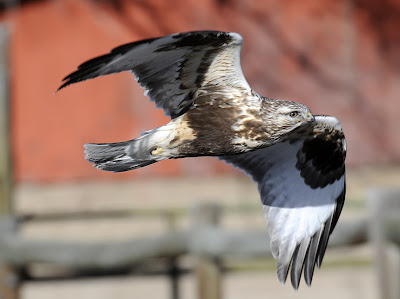>
Raptors appeal to a wide spectrum of birders and nature loves like few other groups of birds. But their habit of perching high in trees or power poles and flying overhead can make photographing them challenging- they often have bright skies behind them that contribute to very dark images of the birds. Your eye & brain combination is much more forgiving than a digital camera sensor, which is why the bird that looked fine in your bins may look like a dark silhouette in your photos. You can play with exposure compensation or waiting for the right light (sunrise and sunset light from behind is quite nice) but if you live in northern latitudes, get out on a sunny day when there is snow on the ground. The snow acts like a big reflector, bouncing light up from underneath the birds. This helps illuminate raptors from below, showing features otherwise lost to underexposure on birds against bright skies. Portrait photographers sometimes use basically the same technique using portable reflectors to bounce sunlight at their models as an alternative to electronic flashes. This is especially helpful on dark raptors like eagles or dark-morph buteos, but works with about any raptor you find on a sunny day with snow on the ground. As a word of caution, light-morph raptors can look really pale in snow light- I've seen light Red-tailed Hawks mistakenly ID'd as Ferruginous Hawks in these conditions, for example, because they look so bright underneath in the bounced light.
We've had a notably dry, warm winter up to this week in Colorado's Northern Front Range where I reside. But we finally got significant snow a couple of days ago, followed by a sunny cold day today. Having the day off, I headed out to drive a nearby route I know can be productive for wintering raptors. One bird I was happy to find was this light-morph adult Harlan's Red-tailed Hawk. It is back for its 4th winter in the same wintering territory, showing the site fidelity of these birds. More amazingly, Jerry Liguori (author of Hawks From Every Angle: How To Identify Raptors in Flight and the upcoming Hawks at a Distance: Identification of Migrant Raptors) photographed the same bird in migration to its Alaskan breeding grounds in the spring of 2009. Feather-by-feather analysis of flight photos from Colorado & Alaska clearly established it was the same bird and we co-authored an article documenting the long distance photo-recovery in Colorado Birds Vol. 44 No. 1, Jan. 2010 (PDF here). It was great seeing this old friend again today and snapping it in the great snow light!



Nearby was another adult Harlan's Hawk- this one more typically dark (perhaps a dark-intermediate morph per Brian Wheeler's Raptors of Western North America.) It was perched nearly over the road and I photographed it leaning out my vehicle window. The snow light really brings out the feather detail in the dark body!

I finished my tour with a raptor that took my breath away- an adult male rufous-morph Ferruginous Hawk. (Rufous individuals with gray heads are likely males vs. females with brown heads per Brian Wheeler's Raptors of Western North America.) This bird wasn't as cooperative as the above Harlan's- it perched in a twiggy cottonwood tree and then flew between me and the sun. On a normal day the flight images would probably have been unsalvageable, but with the snow light and a bit of shadow highlighting in post-processing I could bring up the amazingly rich dark rufous tones of this bird. Look at the gape- that guy is made to gulp large prey like prairie dogs & jack rabbits with a minimum of shredding! I hope you enjoy the images and get the chance to try birding & photographing raptors with snow light sometime this winter.


























































